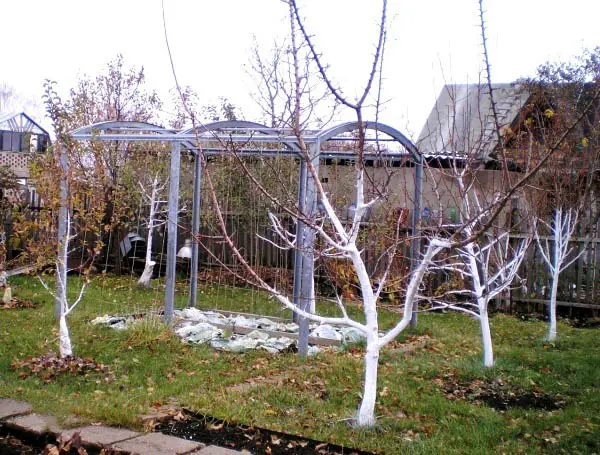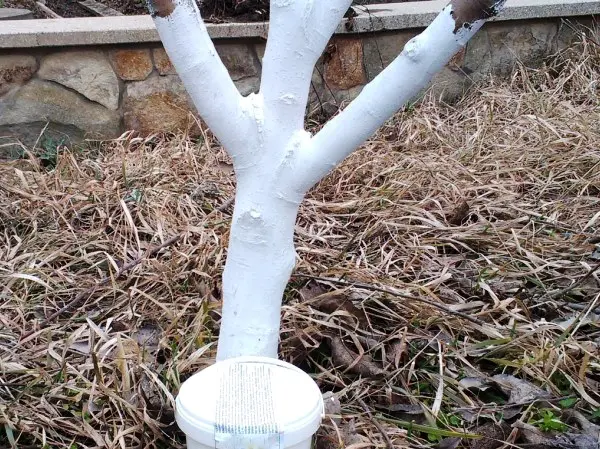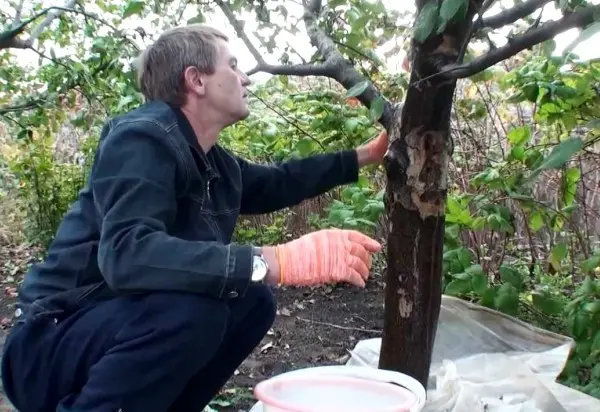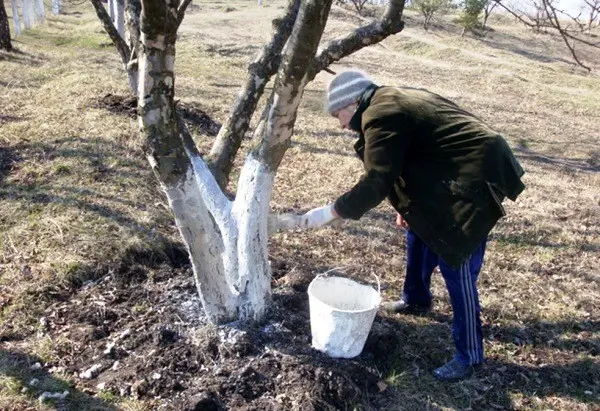Contents
Experienced gardeners recommend caring for apple trees all the time, regardless of the time of year. Only in this case, your garden will delight you with a rich harvest of the varieties you like. Caring for apple trees is not difficult, the main thing is to study the necessary recommendations and try to strictly follow them. It is important to observe the terms of not only planting, pruning, grafting and processing trees, but also the terms of whitewashing. Everyone knows that trees whiten in the spring, but this is not entirely true. One of the important conditions for growing healthy trees is the preliminary whitewashing of apple trees in the fall.
The purpose of autumn whitewash
It is advisable to whiten apple trees twice a year – in autumn and spring. Many gardeners needlessly underestimate the role of whitewashing apple trees in the fall. Its main task is to destroy a huge number of insects, fungal spores and other microorganisms that have chosen the bark as a house for the winter. These can be varieties of aphids, mites, bark beetles and other pests. It is recommended that you definitely whiten the apple tree in the fall if winter thaws often occur in your area. Autumn whitewash protects the tree bark from sunburn, which is possible regardless of air temperature and season. Trees receive such damage not only in summer, but also in early spring, or even in winter. Sometimes this happens in autumn, because at this time of the year more often than in early spring, there is a positive temperature.

White trunks reflect the sun’s rays well, which is important for preventing overheating of trees and cracking of the bark. Whitewashing apple trees in autumn protects the bark from diseases and protects against frost. In winter, large differences in day and night temperatures are also possible, this leads to the fact that the bark cracks, and in spring these places attract pests and pathogenic bacteria. For young seedlings planted in autumn, such whitewashing is essential, since mice and hares love to feast on their delicate bark in winter. Thus, whitewashing in the fall is done not only for beauty, but also for preventive purposes.
Autumn whitewashing will be effective for your garden if you update it in late February or early March. That is, when a round-the-clock temperature of at least + 4-6 degrees is established in your area.

Whitening recipes
Before you start whitewashing, get acquainted with the recommendations for the preparation of whitening compounds. There are different opinions on this matter. Some gardeners recommend whitewashing apple trees with chalk or slaked lime diluted in water. Others advise adding cow dung, soap, milk, PVA glue, clay, water-based paint and other components to this solution.
There are gardeners who prefer just water-based paint with the addition of karbofos (1,5 tablespoons per 2 kg of paint). Hares and mice do not tolerate the smell of karbofos, so this whitewash guarantees the safety of the bark in winter.
Many recommend diluting lime in 1 bucket of water (2-2,5 kg depending on the age of the tree), 250-300 grams of iron or copper sulfate, 1 kg of clay and 1 glass of acrylic paint or 100-150 grams of casein glue. Copper sulphate is recommended to be soaked in hot water in advance.

If you want to use the cheapest method – whitewash with slaked lime – you will have to whitewash the trunk twice so that the thickness of the whitewash is sufficient. For young seedlings, a pure chalk or lime solution of low concentration is recommended so as not to impede the penetration of oxygen under the bark. Having chosen and prepared the composition, you should pay attention to the fact that it should be without lumps, not flow down the tree, be viscous and resemble thick sour cream. The prepared solution should be infused in a bucket for 2-3 hours.
Preparing and coloring trees
Preparation for whitewashing trees must be done correctly and painstakingly, it begins after the apple trees have given up their harvest and the leaves have fallen from them. It includes cleaning the trunk and lower branches from mosses, lichens and exfoliated bark, sealing stem wounds and disinfection. Only after completing all these operations, proceed to whitewashing. It is recommended to do this in October-November, choosing a cloudy and dry day, after the end of the rainy season. Daytime air temperature these days should be around 2-4 degrees Celsius. It is advisable to be in time before the first snow falls. It is necessary to make sure that before the precipitation falls, the whitening composition has time to dry on the tree, and does not flow down with the rain.

First of all, before whitewashing, you need to clean the tree trunk. It is good to do this after rains – damp and wet bark will easily separate from the trunk. Stripping the bark is done with a blunt wooden knife or not a sharp piece of wood, but best of all with your hands so as not to damage the living bark. If you still damaged the bark of an apple tree, you need to treat the place of damage with charcoal or garden pitch.
In advance, a film or tarpaulin is laid under the tree within a radius of a meter and a half. It is recommended to remove crumbled particles of old bark, branches, moss, fungal formations from the site and burn them in another area. If this is not done, they can serve as further centers for the spread of scab and fruit rot. Cracks in the trunk are sealed with special solutions or garden pitch. Disinfection of apple trees in the fall includes treating the tree trunk with a solution of ash and soap. To do this, dissolve in a bucket of hot water 1 kg of salt, 2,5 kg of ash and 2 pieces of laundry soap. The resulting mass should be mixed well, brought to a boil, cooled, and only then proceed to work. The trunk is washed with a rag from all sides.

Only after that you can do whitewashing. It is carried out on a dry, fine day with a convenient brush or spray gun. If you want to do this economically, with minimal mortar loss, then your brush should be the same size as the thickness of the barrel. In the case of using an airbrush, it is necessary to take into account the high consumption of the prepared liquid. Each tree needs to be whitewashed twice. Apple trees can be whitewashed in autumn to the height of the trunk (at least 1,5-1,7 m) or to the height of an outstretched arm. Experienced gardeners believe that the higher the trunk is whitewashed, the better.
Young seedlings are recommended to whiten only before the start of branches. After whitewashing is completed, the remains of the solution are poured onto the ground above the roots, this place also needs to be disinfected, since this is where most pests are preparing to winter.

If you do the whitewashing correctly, taking into account all the recommendations, then the apple trees will not only winter safely, but will also delight you in the summer with their magnificent harvest.
Video “Whitening trees: how, when and with what”
The video talks about when and for what purpose to carry out whitewashing, how to whitewash trees and how to do it correctly.









